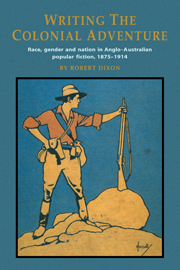 Writing the Colonial Adventure
Writing the Colonial Adventure Book contents
- Frontmatter
- Contents
- List of Illustrations
- Acknowledgements
- Introduction
- 1 The Romance of Property: Rolf Boldrewood and Walter Scott
- 2 Outlaws and Lawmakers: Boldrewood, Praed and the ethics of adventure
- 3 Israel in Egypt: The significance of Australian captivity narratives
- 4 Imperial Romance: King Solomon's Mines and Australian romance
- 5 The New Woman and the Coming Man: Gender and genre in the ‘lost-race’ romance
- 6 The Other World: Rosa Praed's occult fiction
- 7 The Boundaries of Civility: Australia, Asia and the Pacific
- 8 Imagined Invasions: The Lone Hand and narratives of Asiatic invasion
- 9 The Colonial City: Crime fiction and empire
- 10 Beyond Adventure: Louis Becke
- Conclusion
- Notes
- Select Bibliography
- Index
4 - Imperial Romance: King Solomon's Mines and Australian romance
Published online by Cambridge University Press: 05 November 2011
- Frontmatter
- Contents
- List of Illustrations
- Acknowledgements
- Introduction
- 1 The Romance of Property: Rolf Boldrewood and Walter Scott
- 2 Outlaws and Lawmakers: Boldrewood, Praed and the ethics of adventure
- 3 Israel in Egypt: The significance of Australian captivity narratives
- 4 Imperial Romance: King Solomon's Mines and Australian romance
- 5 The New Woman and the Coming Man: Gender and genre in the ‘lost-race’ romance
- 6 The Other World: Rosa Praed's occult fiction
- 7 The Boundaries of Civility: Australia, Asia and the Pacific
- 8 Imagined Invasions: The Lone Hand and narratives of Asiatic invasion
- 9 The Colonial City: Crime fiction and empire
- 10 Beyond Adventure: Louis Becke
- Conclusion
- Notes
- Select Bibliography
- Index
Summary
What I wanted to see was the gold, and what I wanted to do was to get back to civilisation with it as soon as possible. I had had more than enough of uncanny experiences.
G. Firth Scott, The Last LemurianFrom the time of its first publication in 1885, King Solomon's Mines was the most popular, the most successful and the most widely imitated adventure/romance of the period. In his biography of Henry Rider Haggard, Morton Cohen describes the novel's impact on its first generation of readers:
It seems that in the late eighties and early nineties, almost every English novelist tried to write at least one adventure story à la Haggard. In the mid-'nineties, romance was the thing. Readers flocked to it to escape realism and naturalism, and a flood of romance fiction emanating from the New School of Romance satisfied them.
There are a number of recurring plot functions that define the genre's overall shape. Typically, a group of English adventurers plans a journey into unexplored regions to revive their flagging spirits and fortunes. At or near their destination they encounter a relatively advanced white, or partly white, civilisation presided over by a queen, and living in caves or underground. In addition to this fictional lost race, the adventurers also meet more realistic native peoples who are often divided into warring factions. If one of the Englishmen falls in love with a native woman of either the lost or the native race, she usually dies.
- Type
- Chapter
- Information
- Writing the Colonial AdventureRace, Gender and Nation in Anglo-Australian Popular Fiction, 1875–1914, pp. 62 - 81Publisher: Cambridge University PressPrint publication year: 1995


